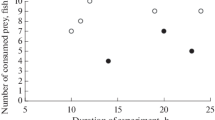Synopsis
The electric organ discharge (EOD) of the little skate,Raja erinacea and winter skate,R. ocellata was recorded both from isolated individuals and from small groups using methods that allowed for the identification of individuals producing EODs. Pulse duration, train lengh, frequency, and pulse patterns are characterized and correlated with behaviour. The two species,R. erinacea andR. ocellata, were found to have characteristically different EOD pulse durations of 70 ms and 217 ms respectively. Isolated skates rarely discharged whereas groups of skates were found to discharge regularly. The EOD was evoked by tactile prodding, physical contact with other skates and electrical stimulation. Skates also discharged reflexively in response to an artificially induced head-positive DC stimulus, sine wave and monopolar square pulses. During approach and contact, skates responded to each other with interacting EOD displays. EOD interaction and pulse duration differences between other species suggest a possible intra-specific communication function of the EOD inRaja.
Similar content being viewed by others
References cited
Akoev, G.N., O.B. Ilyinsky & P.M. Zadan. 1976. Physiological properties of electroreceptors of marine skates. Comp. Biochem. Physiol. 53: 201–209.
Albe-Fessard, D. 1950. Les caractères de la décharge des poissons électriques. Arch. Sci. Physiol. 4: 299-334.
Albe-Fessard, D. & A. Couceiro. 1950. Constitution élémentaire de la décharge naturelle de l'organe électrique de la Raie. J. Physiol. et Pathol. 42: 529–530.
Bauer, R. 1972. High electrical discharge frequency during aggressive behaviour in a mormyrid fish,Gnathonemus petersii. Experientia 28: 669–670.
Belbenoit, P., P. Moller, J. Serrier & S. Push. 1979. Ethological observations on the electric organ discharge behaviour of the electric catfish,Malapterurus electricus (Pisces). Behav. Ecol. Sociobiol. 4: 321–330.
Bennett, M.V.L. 1971. Electric organs. pp. 347–491. In: W.S. Hoar & D.J. Randall (ed.) Fish Physiology, Volume 5, Academic Press, New York.
Bennett, M.V.L. 1961. Modes of operation of electric organs. Ann. N.Y. Acad. Sci. 94: 458–509 Bennett, M.V.L., M. Wurzel & H. Grundfest. 1961. The electrophysiology of electric organs of marine electric fishes. I. Properties of electroplaques ofTorpedo nobiliana. J. Gen. Physiol. 44: 757–804.
Bigelow, H.B. & W.C. Schroeder. 1953a. Fishes of the Gulf of Maine. U.S. Fish Wild. Ser. Fish. Bull. 53: 1–577.
Bigelow, H.B. & W.C. Schroeder. 1953b. Fishes of the western north Atlantic. pp. 176–185. In: Memoir Sears Foundation for Marine Research, Yale University, New Haven.
lack-Cleworth, P. 1970. The role of electrical discharges in the non-reproductive social behavior ofGymnotus carapo L. (Gymnotidae, Pisces). Anim. Behav. Monog. 31: 1–77.
Bratton, B. & J. Ayers. 1982. Electric organ discharge patterns in the skate (Rajidae) and their relation to behavior. Soc. Neurosci. Abstr. 8: 609.
Bray, R.N. & M.A. Hixon. 1978. Night-shocker: Predatory behavior of the Pacific electric ray (Torpedo california). Science 200: 333–334.
Brock, L.G., R.M. Eccles & R.D. Keynes. 1953. The discharge of individual electroplates inRaia clavata. J. Physiol. 122: 4–6.
Bromm, B., K. Hensel & K. Nier. 1975. Response of the ampullae of Lorenzini to static combined electric and thermal stimuli inScyliorhinus canicula. Experientia 31: 615–618.
Ewart, J.C. 1888. On the structure of the electric organ ofRaia circularis. Phil. Trans. Roy. Soc. 179: 410–416.
Ewart, J.C. 1892. The electric organ of the skate. Observations on the structure, relations, progressive development, and growth of the electric organ of the skate. Phil. Trans. Roy. Soc. 183: 389–420.
Heiligenberg, W. & J. Bastian. 1984. The electric sense of weakly electric fish. Ann. Rev. Physiol. 46: 561–583.
Ishiyama, R. 1958. Studies on the rajid fishes (Rajidae) found in the waters around Japan. J. Shimonoseki Coll. Fish. 7: 193–395.
Kalmijn, A.J. 1971. The electric sense of sharks and rays. J. Exp. Biol. 55: 371–383.
Kalmijn, A. 1982. Electric and magnetic field detection in elasmobranch fishes. Science 218: 916–918.
Kramer, B. 1974. Electric organ discharge interaction during interspecific agonistic behaviour in freely swimming mormyrid fish. J. Comp. Physiol. 93: 203–235.
Lissmann, H.W. 1958. On the function and evolution of electric organs in fish. J. Exp. Biol. 35: 156–189.
Lissmann, H.W. 1963. Electric location by fishes. Sci. Amer. 208: 50–59.
Mikhailenko, N.A. 1971. Biological significance and dynamics of electrical discharges in weak electrical fishes of the Black Sea. Zool. Zh. 50: 1347–1352. (in Russian).
Moller, P. 1970. Communication in weakly electric fish,Gnathonemus niger (Mormyridae) 1. Variation of electric organ discharge (EOD) frequency elicited by controlled electric stimuli. Anim. Behav. 18: 768–786.
Montgomery, J.C. 1984a. Frequency response characteristics of primary and secondary neurons in the electrosensory system of the thornback ray. Comp. Biochem. Physiol. 79: 189–195.
Montgomery, J.C. 1984b. Noise cancellation in the electrosensory system of the thornback ray; common mode rejection of input produced by the animal's own ventilatory movement. J. Comp. Physiol. 155: 103–111.
Mortenson, J. & R.H. Whitaker. 1973. Electric discharge in freeswimming female winter skates (Raja ocellata). Amer. Zool. 13: 1266.
Murray, R.W. 1962. The response of the ampullae of Lorenzini of elasmobranchs to electrical stimulation. J. Exp. Biol. 39: 119–128.
Obara, S. & M.V.L. Bennett. 1972. Mode of operation of ampullae of Lorenzini of the skate,Raja. J. Gen. Physiol. 60: 534–557.
Sanderson, J.B. & F. Gotch. 1888. On the electrical organ of the skate. J. Physiol. (London) 9: 137–166.
Sanderson, J.B. & F. Gotch. 1889. On the electrical organ of the skate, part II. J. Physiol. (London) 10: 259–278.
Szabo, T. 1955. Quelques précisions sur le noyau de commande centrale de la décharge électrique chez la Raie (Raja clavata). J. Physiol. (Paris) 47: 283–285.
Author information
Authors and Affiliations
Rights and permissions
About this article
Cite this article
Bratton, B.O., Ayers, J.L. Observations on the electric organ discharge of two skate species (Chondrichthyes: Rajidae) and its relationship to behaviour. Environ Biol Fish 20, 241–254 (1987). https://doi.org/10.1007/BF00005295
Received:
Accepted:
Issue Date:
DOI: https://doi.org/10.1007/BF00005295



